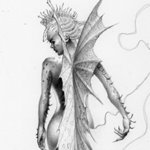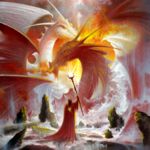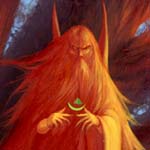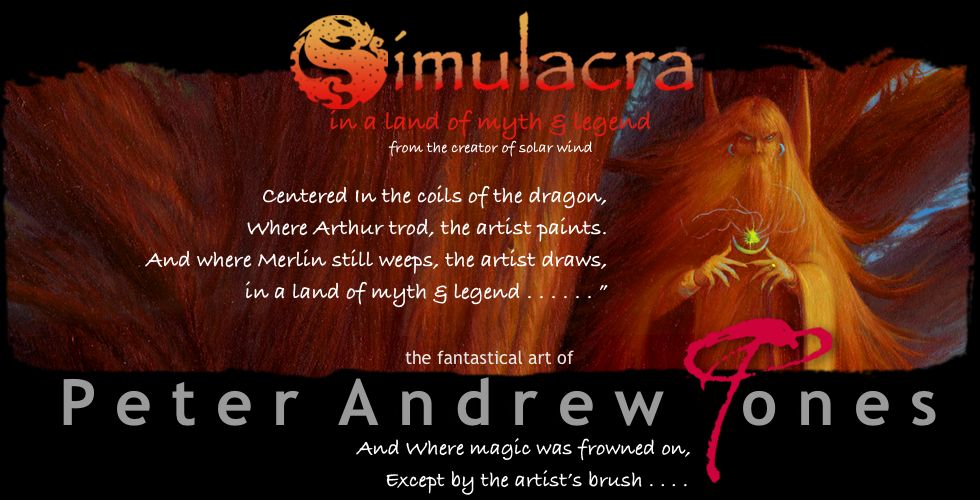 In
1999, while enjoying a successful career since the mid-70s creating
Science Fiction & Fantasy images for a global list of clients, the
artist was out on a Sunday walk in London where he lived and happened
upon Watling Street, which runs alongside St. Pauls Cathedral and which
the artist had known intimately since childhood. In
1999, while enjoying a successful career since the mid-70s creating
Science Fiction & Fantasy images for a global list of clients, the
artist was out on a Sunday walk in London where he lived and happened
upon Watling Street, which runs alongside St. Pauls Cathedral and which
the artist had known intimately since childhood.
 He
pondered what "Watling" meant, especially as a pub he frequented as an
art student ,"The Old Watling" at the bottom of Mayfair, was positioned
close to art galleries he frequented. This seemed significant. He
pondered what "Watling" meant, especially as a pub he frequented as an
art student ,"The Old Watling" at the bottom of Mayfair, was positioned
close to art galleries he frequented. This seemed significant.
 Research
uncovered Watling Street as the root of a famous Roman road. The
remnants of the road, still, run up to Church Stretton in Shropshire,
in "The Marches", a place steeped in myth & legend including
Arthurian. Research
uncovered Watling Street as the root of a famous Roman road. The
remnants of the road, still, run up to Church Stretton in Shropshire,
in "The Marches", a place steeped in myth & legend including
Arthurian.
 So,
he moved his studio from one end of Watling Street to the other, to
paint the myths and legends of The Old Kingdom of Mercia and especially
The Marches area whose legends are, unquestionably, the very root of
modern fantasy art. So,
he moved his studio from one end of Watling Street to the other, to
paint the myths and legends of The Old Kingdom of Mercia and especially
The Marches area whose legends are, unquestionably, the very root of
modern fantasy art.
 Indeed,
a very short walk from the artist's studio will take you to "Merlin's
Cave" said by the locals to still house Merlin himself, immortal,
walled up inside and wailing that he has been imprisoned there by
Morgan Le Fay, Arthur's half sister, as retaliation for his part in
robbing her of her rightful throne. Indeed,
a very short walk from the artist's studio will take you to "Merlin's
Cave" said by the locals to still house Merlin himself, immortal,
walled up inside and wailing that he has been imprisoned there by
Morgan Le Fay, Arthur's half sister, as retaliation for his part in
robbing her of her rightful throne.
 And,
an even shorter walk in the opposite direction will bring one to the
Ludlow Road, at the other end of which you will find Ludlow Castle
where local legend also says that And,
an even shorter walk in the opposite direction will bring one to the
Ludlow Road, at the other end of which you will find Ludlow Castle
where local legend also says that |
Merlin and Uther Pendragon made
their
fateful agreement concerning the yet to be young Arthur.
 Further north? The battlefield of
the fall of Arthur on the Field of Camlan: mortally wounded in error by
his nephew Mordred. Further north? The battlefield of
the fall of Arthur on the Field of Camlan: mortally wounded in error by
his nephew Mordred.
 And
a little further still, Avalon, the Isle of Apples, where the Romans
sent two Legions to Battle what is now referred to as The Welsh only to
find they never returned; no wonder then they called it "The isle of
the Dead". And
a little further still, Avalon, the Isle of Apples, where the Romans
sent two Legions to Battle what is now referred to as The Welsh only to
find they never returned; no wonder then they called it "The isle of
the Dead".
 All this, and more - he had to
paint it! All this, and more - he had to
paint it!
 Before he left
London a friend quipped about the artist's career to date -
"where do you go from up, Peter?" Before he left
London a friend quipped about the artist's career to date -
"where do you go from up, Peter?"
 The response? The response?
 That
the artist, once described by Octopus Books as "The most successful
Science Fiction artist in Britain" should eventually gravitate to the
very geographical centre of where the raw ingredients of so very many
fantasy art works have their roots. That
the artist, once described by Octopus Books as "The most successful
Science Fiction artist in Britain" should eventually gravitate to the
very geographical centre of where the raw ingredients of so very many
fantasy art works have their roots.
 And paint
simulacra. And paint
simulacra.
 Rooted in Middle
English and from the Latin "simulare" the word is disputed to have
either first been used in the 15th century or other sources suggest
the 16th century. Rooted in Middle
English and from the Latin "simulare" the word is disputed to have
either first been used in the 15th century or other sources suggest
the 16th century.
 In
any event, the original meaning of the word appears to have been a
representation of something, such as in a painting, a visual rendering,
of something or somebody tangible In
any event, the original meaning of the word appears to have been a
representation of something, such as in a painting, a visual rendering,
of something or somebody tangible |
and
later, something or somebody from history, and eventually, as became
the "job" of the artist, myth and legend or imagined scenarios.
 Dictionary
definitions do vary greatly (as though in keeping with a simulacrum
itself) including the
idea that it was simply a representation of a person (as in the form of
a painting) yet fantasy art, particularly as practiced by fantasy
artists
since the 1970s, relies so much on the idea of creating visuals of
things
that no longer exist or may never have or, in the case of myth and
legend MAY have existed but, due to non-existent
or extremely unreliable historical records
and with the added issue of the sheer passage of time eroding race
memories, evolved into generally accepted representations of how, for
example, "Merlin the Magician" would have appeared quite regardless of
how he
actually did appear. Dictionary
definitions do vary greatly (as though in keeping with a simulacrum
itself) including the
idea that it was simply a representation of a person (as in the form of
a painting) yet fantasy art, particularly as practiced by fantasy
artists
since the 1970s, relies so much on the idea of creating visuals of
things
that no longer exist or may never have or, in the case of myth and
legend MAY have existed but, due to non-existent
or extremely unreliable historical records
and with the added issue of the sheer passage of time eroding race
memories, evolved into generally accepted representations of how, for
example, "Merlin the Magician" would have appeared quite regardless of
how he
actually did appear.
 We
could then say that in at least some circumstances a simulacrum is an
image that replaces an unclear, variable or long forgotten reality with
its own unique existence, the simulacrum becoming a truth in its own
right with its own reality and no longer being an imitation,
duplication, parody or some such but instead becoming a
concretisation of a fantasy that, by virtue of its own existence and
acceptance by the viewer of that existence, becomes an
accepted
representation of something or somebody that can have no truly reliable
external source of authentication. We
could then say that in at least some circumstances a simulacrum is an
image that replaces an unclear, variable or long forgotten reality with
its own unique existence, the simulacrum becoming a truth in its own
right with its own reality and no longer being an imitation,
duplication, parody or some such but instead becoming a
concretisation of a fantasy that, by virtue of its own existence and
acceptance by the viewer of that existence, becomes an
accepted
representation of something or somebody that can have no truly reliable
external source of authentication.
 In essence,
as an entirely self-contained culture, the simulacrum is accepted and
unquestioned as a truth in itself. In essence,
as an entirely self-contained culture, the simulacrum is accepted and
unquestioned as a truth in itself.
|









